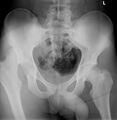Luxation
From WikiLectures
Luxation (dislocation) occurs in case of significant force on the joint (possibly less force in case of predisposition), a serious disorder of congruence occurs. Repositioning can be spontaneous, but usually the joint is dislocated.
According to the mechanism of formation, we distinguish sprains:
- Traumatic – caused by sudden and strong violence that breaks the stabilizing fibrous structures of the joint.
- Habitual – arises as a result of primary or secondary functional disorders or anatomical structure of the joint.
- Pathological – in case of long-term changes in the joint (damage of the joint surfaces during paralysis, loosening of the joint capsule during chronic inflammation).
- Congenital - basis in the presence of congenital dysplasia (hip).
Clinical picture[edit | edit source]
- swelling, hematoma, significant pain
- we monitor innervation, blood supply to the periphery, momentum
- we are investigating whether it is a dislocation fracture on the X-ray
Therapy[edit | edit source]
- we perform under local or general anesthesia
- after repositioning, we check stability and detect damage to soft tissues
- we immobilize the joint
- subsequent rehabilitation is important
Links[edit | edit source]
Related Articles[edit | edit source]
References[edit | edit source]
- BENEŠ, Jiří. Study materials [online]. [cit. 2009]. <http://jirben.wz.cz>.
- ZEMAN, Miroslav, et al. Speciální chirurgie. 2. edition. Praha : Galén, 2004. 575 pp. ISBN 80-7262-260-9.



